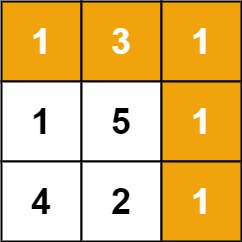Description
Given a m x n grid filled with non-negative numbers, find a path from top left to bottom right, which minimizes the sum of all numbers along its path.
Note: You can only move either down or right at any point in time.
Example 1:

Input: grid = [[1,3,1],[1,5,1],[4,2,1]] Output: 7 Explanation: Because the path 1 → 3 → 1 → 1 → 1 minimizes the sum.
Example 2:
Input: grid = [[1,2,3],[4,5,6]] Output: 12
Constraints:
m == grid.lengthn == grid[i].length1 <= m, n <= 2000 <= grid[i][j] <= 200
Code
和 Unique Paths ㄧ模一樣。
Time Complexity: , Space Complexity:
class Solution {
public:
int minPathSum(vector<vector<int>>& grid) {
int m = grid.size(), n = grid[0].size();
vector<vector<int>> dp(m, vector<int>(n, INT_MAX));
for(int i = 0; i < m; i++) {
dp[i][0] = grid[i][0];
if(i > 0)
dp[i][0] += dp[i - 1][0];
}
for(int i = 0; i < n; i++) {
dp[0][i] = grid[0][i];
if(i > 0)
dp[0][i] += dp[0][i - 1];
}
for(int i = 1; i < m; i++) {
for(int j = 1; j < n; j++) {
dp[i][j] = min(dp[i][j], dp[i][j - 1] + grid[i][j]);
dp[i][j] = min(dp[i][j], dp[i - 1][j] + grid[i][j]);
}
}
return dp[m - 1][n - 1];
}
};